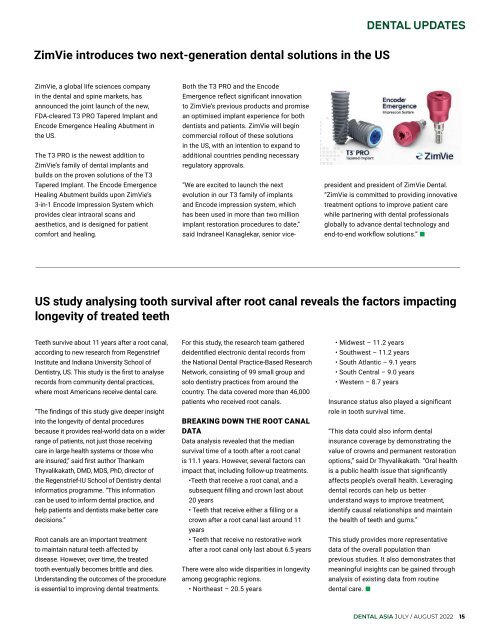Dental Asia July/August 2022
For more than two decades, Dental Asia is the premium journal in linking dental innovators and manufacturers to its rightful audience. We devote ourselves in showcasing the latest dental technology and share evidence-based clinical philosophies to serve as an educational platform to dental professionals. Our combined portfolio of print and digital media also allows us to reach a wider market and secure our position as the leading dental media in the Asia Pacific region while facilitating global interactions among our readers.
For more than two decades, Dental Asia is the premium journal in linking dental innovators and manufacturers to its rightful audience. We devote ourselves in showcasing the latest dental technology and share evidence-based clinical philosophies to serve as an educational platform to dental professionals. Our combined portfolio of print and digital media also allows us to reach a wider market and secure our position as the leading dental media in the Asia Pacific region while facilitating global interactions among our readers.
You also want an ePaper? Increase the reach of your titles
YUMPU automatically turns print PDFs into web optimized ePapers that Google loves.
DENTAL UPDATES<br />
ZimVie introduces two next-generation dental solutions in the US<br />
ZimVie, a global life sciences company<br />
in the dental and spine markets, has<br />
announced the joint launch of the new,<br />
FDA-cleared T3 PRO Tapered Implant and<br />
Encode Emergence Healing Abutment in<br />
the US.<br />
The T3 PRO is the newest addition to<br />
ZimVie’s family of dental implants and<br />
builds on the proven solutions of the T3<br />
Tapered Implant. The Encode Emergence<br />
Healing Abutment builds upon ZimVie’s<br />
3-in-1 Encode Impression System which<br />
provides clear intraoral scans and<br />
aesthetics, and is designed for patient<br />
comfort and healing.<br />
Both the T3 PRO and the Encode<br />
Emergence reflect significant innovation<br />
to ZimVie’s previous products and promise<br />
an optimised implant experience for both<br />
dentists and patients. ZimVie will begin<br />
commercial rollout of these solutions<br />
in the US, with an intention to expand to<br />
additional countries pending necessary<br />
regulatory approvals.<br />
“We are excited to launch the next<br />
evolution in our T3 family of implants<br />
and Encode impression system, which<br />
has been used in more than two million<br />
implant restoration procedures to date,”<br />
said Indraneel Kanaglekar, senior vicepresident<br />
and president of ZimVie <strong>Dental</strong>.<br />
“ZimVie is committed to providing innovative<br />
treatment options to improve patient care<br />
while partnering with dental professionals<br />
globally to advance dental technology and<br />
end-to-end workflow solutions.” ■<br />
US study analysing tooth survival after root canal reveals the factors impacting<br />
longevity of treated teeth<br />
Teeth survive about 11 years after a root canal,<br />
according to new research from Regenstrief<br />
Institute and Indiana University School of<br />
Dentistry, US. This study is the first to analyse<br />
records from community dental practices,<br />
where most Americans receive dental care.<br />
“The findings of this study give deeper insight<br />
into the longevity of dental procedures<br />
because it provides real-world data on a wider<br />
range of patients, not just those receiving<br />
care in large health systems or those who<br />
are insured,” said first author Thankam<br />
Thyvalikakath, DMD, MDS, PhD, director of<br />
the Regenstrief-IU School of Dentistry dental<br />
informatics programme. “This information<br />
can be used to inform dental practice, and<br />
help patients and dentists make better care<br />
decisions.”<br />
Root canals are an important treatment<br />
to maintain natural teeth affected by<br />
disease. However, over time, the treated<br />
tooth eventually becomes brittle and dies.<br />
Understanding the outcomes of the procedure<br />
is essential to improving dental treatments.<br />
For this study, the research team gathered<br />
deidentified electronic dental records from<br />
the National <strong>Dental</strong> Practice-Based Research<br />
Network, consisting of 99 small group and<br />
solo dentistry practices from around the<br />
country. The data covered more than 46,000<br />
patients who received root canals.<br />
BREAKING DOWN THE ROOT CANAL<br />
DATA<br />
Data analysis revealed that the median<br />
survival time of a tooth after a root canal<br />
is 11.1 years. However, several factors can<br />
impact that, including follow-up treatments.<br />
•Teeth that receive a root canal, and a<br />
subsequent filling and crown last about<br />
20 years<br />
• Teeth that receive either a filling or a<br />
crown after a root canal last around 11<br />
years<br />
• Teeth that receive no restorative work<br />
after a root canal only last about 6.5 years<br />
There were also wide disparities in longevity<br />
among geographic regions.<br />
• Northeast – 20.5 years<br />
• Midwest – 11.2 years<br />
• Southwest – 11.2 years<br />
• South Atlantic – 9.1 years<br />
• South Central – 9.0 years<br />
• Western – 8.7 years<br />
Insurance status also played a significant<br />
role in tooth survival time.<br />
“This data could also inform dental<br />
insurance coverage by demonstrating the<br />
value of crowns and permanent restoration<br />
options,” said Dr Thyvalikakath. “Oral health<br />
is a public health issue that significantly<br />
affects people’s overall health. Leveraging<br />
dental records can help us better<br />
understand ways to improve treatment,<br />
identify causal relationships and maintain<br />
the health of teeth and gums.”<br />
This study provides more representative<br />
data of the overall population than<br />
previous studies. It also demonstrates that<br />
meaningful insights can be gained through<br />
analysis of existing data from routine<br />
dental care. ■<br />
DENTAL ASIA JULY / AUGUST <strong>2022</strong> 15


















